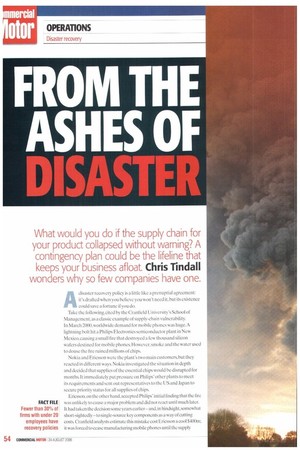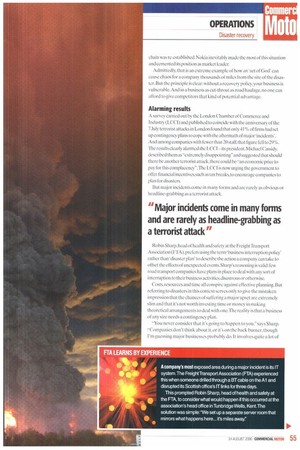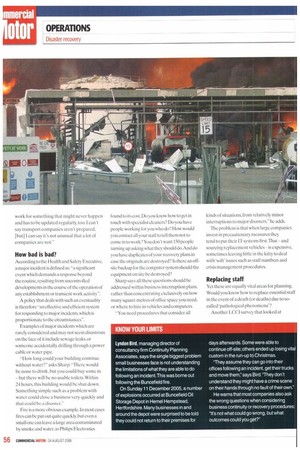FROM THE ASHES OF
Page 54

Page 55

Page 56

Page 57

If you've noticed an error in this article please click here to report it so we can fix it.
D SiiSTER
What would you do if the supply chain for your product collapsed without warning? A contingency plan could be the lifeline that keeps your business afloat. Chris Tindall wonders why so few companies have one.
Adisaster recovery policy is a little like a prenuptial agreement: it's drafted when you believe you won't need it, but its existence could save a fortune if you do.
Take the following. cited by the Cranfield University's School of Management, as a classic example of supply-chain vulnerability. In March 2000. worldwide demand for mobile phones was huge. A lightning bolt hit a Philips Electronics semiconductor plant in New Mexico, causing a small fire that destroyed a few thousand silicon wafers destined for mobile phones. However, smoke and the water used to douse the fire ruined millions of chips.
Nokia and Ericsson were the plant's two main customers, but they reacted in different ways. Nokia investigated the situation in depth and decided that supplies of the essential chips would be disrupted for months. It immediately put pressure on Philips' other plants to meet its requirements and sent out representatives to the I. JS and Japan to secure priority status for all supplies of chips.
Ericsson,on the other hand. accepted Philips' initial finding that the lire was unlikely to cause a major problem and did not react until much later. It had taken the decision some years earlier—and, in hindsight,somewhat short-sightedly — to single-source key components as a way of cutting costs. Cranfield analysts estimate this mistake cost Ericsson a cool W0n1; it was forced to cease manufacturing mobile phones until the supply chain was re-established, Nokia inevitably made the most of this situation and cemented its position as market leader.
Admit tedly,that is an extreme example of how an 'act of God can cause chaos for a company thousands of miles from the site of the disaster. But the principle is clear:without a recovery policy, your business is vulnerable. And in a business as cut-throat as road haulage, no one can afford to give competitors that kind of potential advantage.
Alarming results
A survey carried out by the London Chamber of Commerce and Indusny (LCCI) and published to coincide with the anniversary of the 7July terrorist attacks in London found that only 41% of firms had set up contingency plans to cope with the aftermath of major 'incidents'. And among companies with fewer than 20 staff, that figure fell to 29%. The results clearly alarmed the LCCI —its president.Michael Cassidy, described them as"extremely disappointing" and suggested that should there be another terrorist attack,there could be "an economic price to pay for this complacency".The LCCI is now urging the government to offer financial incentives, such as tax breaks, to encourage companies to plan for disasters.
But major incidents come in many forms and are rarely as obvious or headline-grabbing as a terrorist attack.
Robin Sharp, head of health and safety at the Freight 'transport Association (1.'IA), prefers using the term 'business interruption policy' rather than 'disaster plan' to describe the action a company can take to offset the effects of unexpected events.Sharp's reasoning is valid: few road transport companies have plans in place to deal with any sort of interruption to their business activities,disastrous or otherwise.
Costs, resources and time all conspire against effective planning. But referring to disasters in this context serves only to give the mistaken impression that the chances of suffering a major upset are extremely slim and that it's not worth investing time or money in making theoretical arrangements to deal with one.The reality is that a business of any size needs a contingency plan.
"You never consider that it's going to happen to you," says Sharp. "Companies don't think about it, or it's on the back burner, though I'm guessing major businesses probably do. It involves quite a lot of work for something that might never happen and has to be updated regularly, too. I can't say transport companies aren't prepared, [but] I can say it's not unusual that a lot of companies are not,"
How bad is bad?
According to the Health and Safety Executive, a major incident is defined as: "a significant event which demands a response beyond the routine, resulting from uncontrolled developments in the course of the operation of any establishment or transient work activity-.
A policy that deals with such an eventuality is therefore "an effective and efficient system for responding to major incidents, which is proportionate to the circumstances-.
Examples of major incidents which are rarely considered and may not seem disastrous on the face of it include sewage leaks, or someone accidentally drilling through a power cable or water pipe.
"How long could your building continue without water?" asks Sharp. "There would be none to drink ,hut you could buy some in but there will be no usable toilets. Within 24 hours, this building would be shut down. Something simple such as a problem with water could close a business very quickly and that could be a disaster."
Fire is a more obvious example. In most cases fires can be put out quite quickly, but even a small one can leave a large area contaminated by smoke and water, as Philips Electronics found to its cost. Do you know how to get in touch with specialist cleaners? Do you have people working for you who do? How would you contact all your staff to tell them not to come in to work? You don't want 150 people turning up asking what they should do. And do you have duplicates of your recovery plans in ease the originals are destroyed? Is there an offsite backup for the computer system should the equipment on site be destroyed?
Sharp says all these questions should be addressed within business interruption plans, rather than concentrating exclusively on how many square metres of office space you need, or where to hire in vehicles and computers.
-You need procedures that consider all kinds of situations, from relatively minor interruptions to major disasters," he adds.
The problem is that when large companies invest in precautionary measures they tend to put their IT systems first.That and sourcing replacement vehicles is expensive, sometimes leaving little in the kitty to deal with 'soft' issues such as staff numbers and crisis management procedures.
Replacing staff
Yet these are equally vital areas for planning. Would you know how to replace essential staff in the event of a death (or deaths) due to socalled 'pathological phenomena'?
Another LCCI survey that looked at the effects of an avian flu pandemic lasting 12 weeks revealed what most companies probably wouldn't like to admit —more than 20% said they would no longer be able to continue trading if between 10% and 30% of staff became unavailable for work."It sounds harsh," Sharp admits,"but how do you replace specialist staff?This could he lorry drivers."
And then there's insurance. Even after an incident, your overheads still exist. People still need wages, and hire-purchase agreements must be honoured. If your office building is destroyed, it could take a year or more for the site to be cleared and rebuilt.There probably aren't many haulage companies that could pay out interim costs and have adequate insurance to keep them afloat during that time.
There are many ways in which premises could be destroyed, but you shouldn't have to consider every single possibility, according to Lyndon Bird of consultancy firm Continuity Planning Associates.
Instead, accept there are scenarios that are likely and some that are highly unlikely. Next, consider whether there would be total or partial destruction of your premises if these incidents were to occur. Bird says there are usually only about six basic scenarios for each set-up, and therefore six possible likely outcomes to be considered.
This keeps things relatively simple.which is a benefit: if a business plan becomes too complex, people will be bombarded with information and ignore the details.
Bird says:"Business continuity is not necessarily expensive, and it's the most fundamental thing you can do. It's not just about negative things.There are positives: people have to understand it's not only a bureaucratic nightmare you have to get through."
He lists hidden benefits, such as being able to truly understand the workings of your business,'re-engineering' it and consequently making it more resilient, which could give it a competitive advantage."You won't get on the tender list any more if you can't prove you have a recovery procedure in place," he suggests.
Boxing clever It's not necessarily about how much money you can throw at a problem. but how much thought and logic you can put into solving a disaster scenario, Bird cites one person who worked for a company that made boxes and sold them to corner shops in the north of England — customers who were not prepared to buy in bulk from manufacturers.
A lire destroyed the company's premises and they began to panic, wondering how they could continue trading.
"But then someone said,'What business are we in? We aren't in the business of making boxes: we're in the business of selling small numbers of them to shops. Why don't we just buy in bulk, get a warehouse, break them down and sell them individually?'
"Five years later," he concludes,"they were making much more profit as a result of a disaster. In some ways. disaster contingency plans are not very expensive.They are about thinking creatively and logically." •
























































































































































































